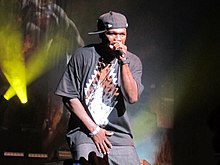
Back Kletsrym Afrikaans Rap ALS راب Arabic راپ ARY راب ARZ ৰেপাৰ Assamese Rap AST Rep Azerbaijani رپ AZB Рэп Byelorussian


Rapping (also rhyming, flowing, spitting,[1] emceeing,[2] or MCing[2][3]) is an artistic form of vocal delivery and emotive expression that incorporates "rhyme, rhythmic speech, and [commonly] street vernacular".[4] It is usually performed over a backing beat or musical accompaniment.[4] The components of rap include "content" (what is being said, e.g., lyrics), "flow" (rhythm, rhyme), and "delivery" (cadence, tone).[5] Rap differs from spoken-word poetry in that it is usually performed off-time to musical accompaniment.[6] It also differs from singing, which varies in pitch and does not always include words. Because they do not rely on pitch inflection, some rap artists may play with timbre or other vocal qualities. Rap is a primary ingredient of hip-hop music, and so commonly associated with the genre that it is sometimes called "rap music".
Precursors to modern rap music include the West African griot tradition,[7] certain vocal styles of blues[8] and jazz,[9] an African-American insult game called playing the dozens (see Battle rap and Diss),[10] and 1960s African-American poetry.[11] Stemming from the hip-hop cultural movement, rap music originated in the Bronx, New York City, in the early 1970s and became part of popular music later that decade.[12] Rapping developed from the announcements made over the microphone at parties by DJs and MCs, evolving into more complex lyrical performances.[13]
Rap is usually delivered over a beat, typically provided by a DJ, turntablist, or beatboxer when performing live. Much less commonly a rapper can decide to perform a cappella, meaning without accompaniment of any sort. When a rap or hip-hop artist is creating a song, "track", or record, done primarily in a production studio, most frequently a producer provides the beat(s) for the MC to flow over. Stylistically, rap occupies a gray area between speech, prose, poetry, and singing.[14] The word, which predates the musical form, originally meant "to lightly strike",[15] and is now used to describe quick speech or repartee.[16] The word has been used in the English language since the 16th century. In the 1960s the word became a slang term meaning "to converse" in African American vernacular, and very soon after that came to denote the musical style.[17] The word "rap" is so closely associated with hip-hop music that many writers use the terms interchangeably.
Rap music has played a significant role in expressing social and political issues, addressing topics such as racism, poverty, and political oppression.[18] By the 21st century, rap had become a global phenomenon, influencing music, fashion, and culture worldwide.[19]
- ^ Duneier, Kasinitz, Murphy (2014). The Urban Ethnography Reader. Oxford University Press. ISBN 978-0-19-974357-5.
{{cite book}}: CS1 maint: multiple names: authors list (link) - ^ a b Edwards 2009, p. xii.
- ^ Edwards 2009, p. 81.
- ^ a b Cite error: The named reference
:0was invoked but never defined (see the help page). - ^ Edwards 2009, p. x.
- ^ Golus, Carrie (2012). From Def Jam to Super Rich. Twenty First Century Books. p. 22. ISBN 978-0-7613-8157-0.
- ^ Cite error: The named reference
:2was invoked but never defined (see the help page). - ^ Cite error: The named reference
tonywas invoked but never defined (see the help page). - ^ Cite error: The named reference
digitopiawas invoked but never defined (see the help page). - ^ Smith (October 16, 2014). "Not just Yo' Mama but Rap's Mama: The Dozens, African American Culture and the Origins of Battle Rap". U.S. STUDIES ONLINE PGR & ECR NETWORK FOR THE BRITISH ASSOCIATION FOR AMERICAN STUDIES. British Association of American Studies. Archived from the original on March 4, 2023. Retrieved March 4, 2023.
- ^ Cite error: The named reference
ny-aliwas invoked but never defined (see the help page). - ^ Hoffmann, Frank (2007). Rhythm and Blues, Rap, and Hip-Hop (American Popular Music). Checkmark Books. pp. 63. ISBN 978-0-8160-7341-2.
- ^ "Rap | History, Artists, & Facts | Britannica". www.britannica.com. July 23, 2024. Archived from the original on October 4, 2023. Retrieved August 2, 2024.
- ^ Kovacs, Karl (2014). From Grassroots to Comercialization: Hip Hop and Rap Music in the USA. Anchor Academic Publishing. p. 4. ISBN 9783954892518. Archived from the original on April 14, 2023. Retrieved March 19, 2023.
- ^ "Dictionary.com". Archived from the original on June 27, 2009. Retrieved February 2, 2008.
- ^ Oxford English Dictionary
- ^ Safire, William (1992), "On language; The rap on hip-hop", The New York Times Magazine.
- ^ MasterClass (June 17, 2021). "Hip-Hop Music Guide: History of Hip-Hop and Notable Artists". MasterClass. Retrieved June 17, 2021.
- ^ Davis-Marks, Isis. "Chronicling Hip-Hop's 45-Year Ascendance as a Musical, Cultural and Social Phenom". Smithsonian Magazine. Archived from the original on August 2, 2024. Retrieved August 2, 2024.